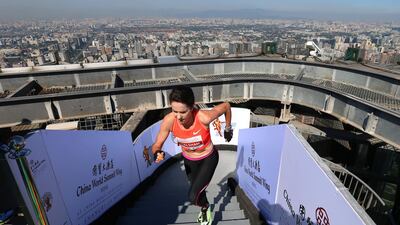A few months ago, we wrote about the simple but effective regimen of stair-climbing – an activity that's inexpensive, easily accessible and boosts both body and brain health.
Most experts maintain that injury-free adults should aim to climb stairs daily for 10 minutes, preceded by a five-minute warm-up, which could include walking on flat ground, and some basic squats and lunges. Once you’re comfortable doing 70 minutes a week, add flights until you’ve reached at least 30 minutes a day. But what next? If you find stair-climbing physically and mentally productive, you can take it to the next level: stair-running.
Sometimes called tower-running or sky-running, the sport is gaining popularity in the UAE. In addition to international competitions hosted here, organisations such as Gulf for Good and Zayed Sports City regularly organise stair-running events and races in the country’s many high-rises.
Singapore-based professional stair-runner Suzy Walsham came first in the women’s category during the Dubai leg of the 2017 Vertical World Circuit, scaling up the 52-storey Jumeirah Emirates Towers in 8 minutes and 16 seconds. Walsham also won top honours at the inaugural 82-floor Climb to Abu Dhabi vertical marathon hosted by Etihad Towers this year.
Before she became a professional stair-runner, the 43-year-old Australian was an 800-metre and 1,500-metre track athlete, who has won several Australian national titles and competed at the 2006 Commonwealth Games. She tells us how she got involved with stair-running and about its many joys and jubilations.
What do you enjoy most about stair-running?
AI love the challenge of it. It is incredibly tough, but I love trying to work out how I can go faster and how I can train my mind to overcome the physical challenge. I get a great sense of satisfaction when I finish a race. I also like that it's an exercise where factors such as the weather are not really an issue, and you can get a really tough workout in a relatively short period of time.
What other sports would you compare stair-running to?
I have a middle distance track background; however, stair-running is harder physically due to the sustained lactic acid, particularly for a tall building, although you can recover quicker as there is much less impact. Stair-runners often talk about what sport is most similar, and we think speedskating and rowing, to some extent, could be close cousins. Stair races are different to track races, so I have enjoyed applying my skills to a new sport.
How did you get involved with the sport?
My first race was the Swissotel Vertical Marathon in Singapore in 2006, prior to which I never did any stair-training or used the stairs in regular life. I happened to win that race, and won a trip to New York to compete in the Empire State Building Run-Up [which she won]. Back then, there weren’t many races, but I quickly developed a passion for the sport.
After the birth of my son, I turned, once again, to the stairs to get back into shape, and from 2012 I started to do a lot more international races – in 2016 I did 16 stair races. This year, I competed in Abu Dhabi and Dubai and I won both. I found the events were excellently run and had a great atmosphere, and I really enjoyed visiting the UAE.
How should active but amateur stair-climbers train themselves to compete in a stair-running race?
If you are going to do a race, then you ought to do some training on the stairs. It can seem super-hard at first, so start out with manageable sessions; stop after five or 10 floors for a set amount of rest time, and then increase the number of floors you do before stopping.
Before a race, I recommend to at least cover the race distance in training, but preferably aim to do 50 per cent more in a session – that way the race will feel easier. You can also practise your technique and find out what works best: how you use the handrail, whether you take one step at a time or two, and practise pacing yourself. Too many runners start out way too fast; I always recommend to go out slower and then find your rhythm and build on that.
What’s your dream tower-running destination?
Without a doubt, I am desperate for there to be a race up the Burj Khalifa. I have been to Dubai several times and I refuse to go to the [Burj’s] observation deck until I can run there myself.
What are some of the physical and mental-health benefits of making stair-climbing a regular part of a person’s life?
It is a fantastic exercise to build fitness and strength – you get the cardio because your heart rate goes through the roof, but you also get strength from pushing your body up the stairs – great for legs/glutes – and when you use the handrail, you also get a good arm workout. After some races, it is my arms that are sore the next day and not my legs. It also has much less impact than running, so there is much less chance of injury.
Stair fitness is also very convenient if you live or work in a building, and you can get an amazing workout in just 15 to 20 minutes, without having to worry about the weather or pollution, or paying expensive gym fees. It is also a great de-stressor as you can’t really think of anything else when you are doing a running session up the stairs, and the endorphins and sense of achievement you will feel will put you in a good mood.
________________
Read more:
A look at the many benefits of stair-climbing
Having a ball: mysofascial release explained
Kayla Itsines on fame and fitness ahead of UAE visit
________________


